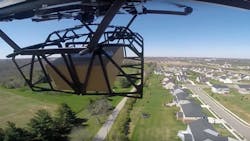Over the last four years or so, companies like Amazon, Deutsche Post DHL Group and Mercedes-Benz have been launching projects that test drone use in package and parcel delivery. Electric vehicle maker Workhorse Group has been at it as long as anyone, and working with delivery companies in actual use, is now providing more details on where and how it believes delivery drones make the best sense.
At least under the current rules and restrictions, that is, and with the company's HorseFly drone. The Federal Aviation Administration (FAA) requires that drones be flown within a line of sight, which is interpreted as allowing up to two miles of flight. It also means that drones can't just be dispatched autonomously while an operator isn't watching them.
Therein lies the rub. Workhorse, testing out drone delivery with UPS, has found that using drones in rural areas where some homes may be set back quite a distance could in fact cut down on miles driven and delivery truck idling time, but the FAA rules limit the possibilities.
"UPS handles 15.8 million packages on an average day; FedEx handles 9 million," said John LaFleur, vice president of vehicle programs at Workhorse, at this year's Work Truck Show. "The biggest day of the year for deliveries is Dec. 20, and they deliver approximately 28 million packages that day.
"These have historically all been delivered by diesel-powered trucks," he continued. "We talk about saving costly miles driving. If every UPS driver saved one mile of driving a day per year, it would save $54 million in fuel costs."
So scale can help drones realize the best ROI in delivery. The cost of delivering with a drone, LeFleur noted, "is pennies compared to leaving a diesel truck running, or even the idea of driving all the way back — a mile, mile-and-a-half, two miles — to a location."
Here's video of the drone delivery system UPS has tested out with Workhorse:
Breaking it down, the delivery truck driver parks and stops the vehicle, then loads the package delivery drone. Using a touchscreen, the driver inputs a destination for the drone to take the package — perhaps to a home set back a mile or two. The driver could move on to make other deliveries while the drone is doing its thing, but again, must maintain line of sight with the drone.
"We're working with FAA to see if we can relax the rule so the driver could take their eye off it for a slight amount of time, which would really speed this whole thing up as far as seeing this [system] in deliveries all over the country," LaFleur said.
What else might help? Multiple drones could be housed on top of the delivery truck, for one thing, and sent off on their way carrying packages. Also, LaFleur noted that Workhorse's HorseFly drone now must re-dock when the vehicle is stationary, but the company is working on it being able to land while the vehicle is moving. That would also add potential efficiency to the setup.
Another tweak Workhorse is developing, meanwhile, is additional maneuverability of the drone for safety. If it were supposed to land and deliver a package but a dog or person happened to be at the landing site, for instance, either the driver operating it or perhaps the drone itself could detect that and land safely elsewhere, LaFleur told Fleet Owner.
Unlike some others have been testing drone use, Workhorse's HorseFly drone delivery system isn't likely to be used in cities. "You're not going to see this very soon in an urban situation. There are people walking around, wires, cars and other things all around," LaFleur said. "This is meant to launch primarily in rural areas, at least initially."
Workhorse recently announced its new N-Gen electric van, which will be able to be spec'd with a HorseFly drone. Meanwhile, the company's W-15 electric pickup — no drone included yet — won the most innovative vehicle award at the 2018 Work Truck Show.
About the Author
Aaron Marsh
Aaron Marsh is a former senior editor of FleetOwner, who wrote for the publication from 2015 to 2019.

